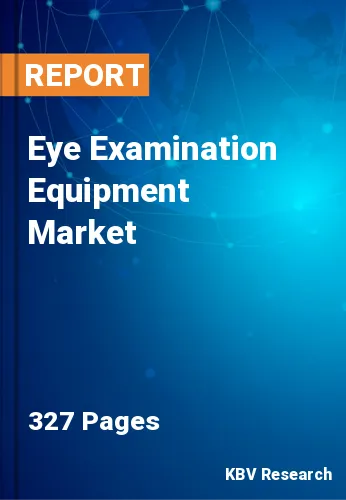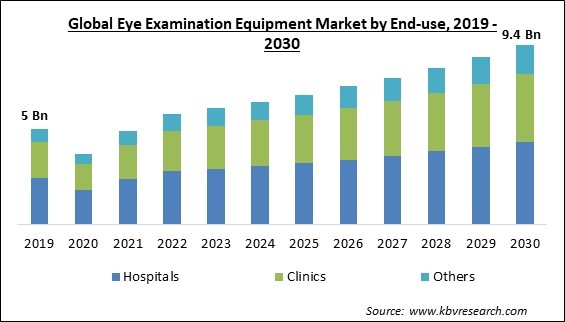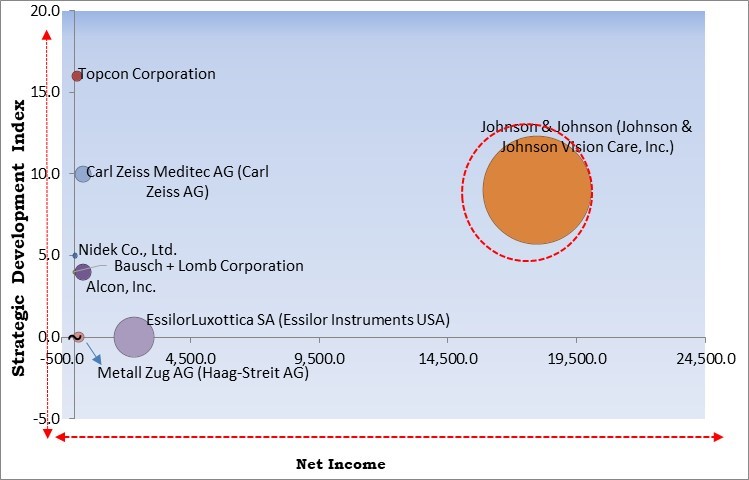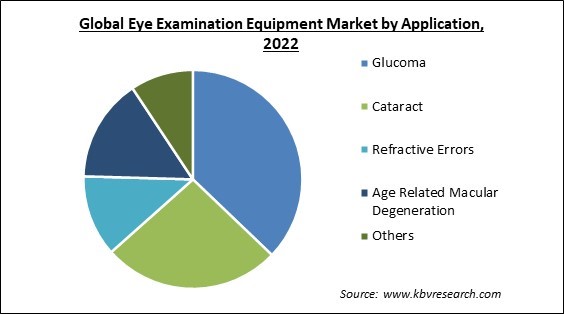
The Global Eye Examination Equipment Market size is expected to reach $9.4 billion by 2030, rising at a market growth of 6.4% CAGR during the forecast period.
The optical coherent tomography (OCT) scanners work on the principle of low-coherence interferometry. Consequently, the optical coherent tomography (OCT) scanners segment will register more than 1/5th share of the market by 2030 They emit a beam of near-infrared light split into two paths. One path is directed into the examined tissue, while the other is directed into a reference mirror. The light reflected or scattered back from the tissue is combined with the reference light, and the interference pattern is analyzed to create an image. OCT scanners have revolutionized medical imaging by providing non-invasive, high-resolution imaging capabilities across various medical specialties.

The major strategies followed by the market participants are Partnerships as the key developmental strategy in order to keep pace with the changing demands of end users. In February, 2023, NIDEK came into partnership with HOYA Vision Care with an aim to deliver eye care professionals a chance to access a comprehensive portfolio of optical instruments and products. In August, 2021, Topcon teamed up with RetInSight GmbH. This partnership would lead to enhanced clinical decision-making and efficient disease management.
Based on the Analysis presented in the KBV Cardinal matrix; Johnson & Johnson (Johnson & Johnson Vision Care, Inc.) is the major forerunner in the Market. In September, 2021, Johnson & Johnson partnered with Black EyeCare Perspective to support the future of optometry and work together to create quality, equitable experiences along with healthier outcomes across communities. Companies such as Topcon Corporation, Carl Zeiss Meditec AG (Carl Zeiss AG) and Nidek Co., Ltd. are some of the key innovators in the Market.

The COVID-19 pandemic significantly impacted various sectors, including the healthcare industry and the market for eye examination equipment. During the initial stages of the pandemic, many manufacturing facilities and supply chains were disrupted due to lockdowns, labor shortages, and restrictions on movement. This caused delays in the manufacturing and distribution of eye examination equipment, resulting in potential shortages in certain regions. As a result, the demand for eye examination equipment temporarily declined. The pandemic raised understanding of the significance of eye health, especially among individuals spending more time on digital devices for work and leisure. This further led to a long-term increase in demand for eye examinations and related equipment. Although there may have been short-term difficulties, the market's future outlook is still favorable because eye health is vital to overall healthcare.
The WHO reports that people are living longer overall. Most people today plan to live until their sixties and beyond. By 2030, one in six people will be 60 or older. 1.4 billion people will be above 60 by now, up from 1 billion in 2020. Two-thirds of the world's population over 60 will live in low- and middle-income nations by 2050. The aging population's increased susceptibility to age-related eye conditions and the recognition of the importance of regular eye exams drive the demand. This demographic shift positively impacts the market by fostering growth, innovation, and improved eye care services for older adults.
Modern lifestyles, characterized by increased screen time, exposure to digital devices, and limited outdoor activities, have contributed to a higher incidence of conditions like digital eye strain, myopia (near-sightedness), and dry eye syndrome. The rising prevalence of diabetes, especially type 2 diabetes, is closely linked to an increased incidence of diabetic retinopathy. The increasing prevalence of eye disorders has necessitated early detection and treatment, driving demand. In addition, increasing eye care awareness and the accessibility of technologically advanced eye examination equipment are expected to drive market growth over the forecast period.
Low awareness and limited access to eye care in low-income economies pose a significant obstacle for the market. Access to eye care services and equipment is extremely limited in many developing nations. This lack of access can result in a lack of awareness regarding the significance of regular eye examinations and the dangers of vision loss. In addition, efforts must be made to increase the accessibility of eye examination equipment in low-income countries so that individuals can access the necessary tools for diagnosing and treating vision-related issues. Due to limited eye care awareness in economies with low income, the market will be hampered.
Based on end-use, the market is fragmented into hospitals, clinics, and others. In 2022, the hospitals segment registered the highest revenue share in the market. It is crucial for diagnosing and monitoring various eye conditions and diseases in hospitals and other healthcare settings. Ophthalmologists, optometrists, and other eye care professionals use these tools and devices to assess patients' visual health and provide appropriate treatment. Hospitals are vital for providing comprehensive eye care, early diagnosis of eye diseases, and proper treatment and management of visual and ocular conditions.
By application, the market is classified into glaucoma, cataract, refractive errors, age related macular degeneration, and others. The cataract segment recorded a remarkable revenue share in the market in 2022. While cataract treatment primarily involves surgical intervention, eye examination equipment plays a significant role in diagnosing, evaluating, and preparing for cataract surgery. These devices measure a patient's refractive error and corneal curvature. These measurements are crucial for calculating the intraocular lens (IOL) power needed to correct vision during cataract surgery. Advances in these technologies continue to enhance the safety and effectiveness of cataract diagnosis and treatment.

On the basis of product, the market is segmented into optical coherent tomography (OCT) scanners, ophthalmic ultrasound imaging systems, corneal topography systems, slit lamps, tonometer, ophthalmoscopes, perimeters/visual field analyzers, fundus cameras, autorefractors & keratometers (phoropters), and others. The slit lamps segment covered a considerable revenue share in the market in 2022. A slit lamp is a crucial piece of eye examination equipment used by ophthalmologists and optometrists to examine the various structures of the eye, including the anterior segment (front part of the eye). It consists of a binocular microscope with an adjustable light source that produces a thin, intense light beam. They play a pivotal role in diagnosing and monitoring eye conditions, guiding treatment decisions, and assessing the fit and comfort of contact lenses. The integration of advanced imaging technologies further enhances their diagnostic capabilities.
| Report Attribute | Details |
|---|---|
| Market size value in 2022 | USD 5.8 Billion |
| Market size forecast in 2030 | USD 9.4 Billion |
| Base Year | 2022 |
| Historical Period | 2019 to 2021 |
| Forecast Period | 2023 to 2030 |
| Revenue Growth Rate | CAGR of 6.4% from 2023 to 2030 |
| Number of Pages | 327 |
| Number of Table | 444 |
| Report coverage | Market Trends, Revenue Estimation and Forecast, Segmentation Analysis, Regional and Country Breakdown, Competitive Landscape, Companies Strategic Developments, Company Profiling |
| Segments covered | Product, Application, End-use, Region |
| Country scope | US, Canada, Mexico, Germany, UK, France, Russia, Spain, Italy, China, Japan, India, South Korea, Singapore, Malaysia, Brazil, Argentina, UAE, Saudi Arabia, South Africa, Nigeria |
| Growth Drivers |
|
| Restraints |
|
Region-wise, the market is analysed across North America, Europe, Asia Pacific, and LAMEA. In 2022, the North America region witnessed the largest revenue share in the market. This will be due to the expanding number of individuals with vision impairment, which will offer an enormous challenge to eye care service providers, prompting them to acquire advanced diagnostic equipment. The market is driven by the rising number of moderate-to-severe visual impairments and myopia due to the growing elderly population. Increasing investments by governments and other private organizations to address the region's significant unmet healthcare requirements will likely stimulate the market's expansion.
Free Valuable Insights: Global Eye Examination Equipment Market size to reach USD 9.4 Billion by 2030
The market research report covers the analysis of key stake holders of the market. Key companies profiled in the report include Alcon, Inc., Ziemer Ophthalmic Systems AG, Nidek Co., Ltd., Topcon Corporation, Carl Zeiss Meditec AG (Carl Zeiss AG), Johnson & Johnson (Johnson & Johnson Vision Care, Inc.), EssilorLuxottica SA (Essilor Instruments USA), Metall Zug AG (Metall Zug AG), Bausch + Lomb Corporation (Bausch Health Companies, Inc.), and HEINE Optotechnik GmbH & Co. KG.
By End Use
By Application
By Product
By Geography
This Market size is expected to reach $9.4 billion by 2030.
Increasing Proportion of an Ageing Population are driving the Market in coming years, however, Lack of Eye Care Awareness in Low-Income Countries restraints the growth of the Market.
Alcon, Inc., Ziemer Ophthalmic Systems AG, Nidek Co., Ltd., Topcon Corporation, Carl Zeiss Meditec AG (Carl Zeiss AG), Johnson & Johnson (Johnson & Johnson Vision Care, Inc.), EssilorLuxottica SA (Essilor Instruments USA), Metall Zug AG (Metall Zug AG), Bausch + Lomb Corporation (Bausch Health Companies, Inc.), and HEINE Optotechnik GmbH & Co. KG.
The expected CAGR of this Market is 6.4% from 2023 to 2030.
The Glucoma segment is leading the Market by Application in 2022; thereby, achieving a market value of $3.3 billion by 2030.
The North America region dominated the Market by Region in 2022 and would continue to be a dominant market till 2030; thereby, achieving a market value of $3.3 billion by 2030.
Our team of dedicated experts can provide you with attractive expansion opportunities for your business.
